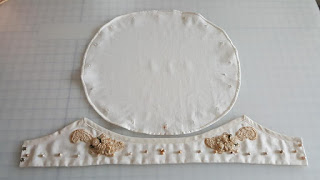Have you seen this on Instagram or Facebook? It is a call to all costumers and creators to join together for the holiday season in sharing our projects for #homefortheholidays2020. While we can't be together during this time, we can be together in spirit in our shared fashions and creations.
This post is to share with you my project and the history behind it. Inspiration for me came from this little beauty:She is a Holiday Memories Barbie by Mattel, Hallmark Special Edition. The inside of her presentation box reads:
"As the snowfall creates a memorable winter scene, so too will Holiday Memories Barbie. Elegantly dressed in an early twentieth-century inspired outfit, she commemorates the 85th anniversary of Hallmark Cards. Second in a series of Special Edition Barbie dolls created exclusively for Hallmark, Holiday Memories Barbie was inspired by antique greeting card artwork from the Hallmark Design Collection. She adds a festive touch to any holiday season.
Dressed for a stylish afternoon downtown, Holiday Memories Barbie looks sensational in her dazzling red satin dress peeking beneath a flocked coat with "faux fur" collar and sleeves. She plans on visiting the stationer's shop, where she selects replicas of holiday postcards from Hallmark's antique card collection. They are similar to those Mr. J.C. Hall, founder of Hallmark, carried with him when he arrived in Kansas City in 1910. While greeting cards may have replaced the postcards of yesteryear, Barbie knows a card saying "Hello! I'm thinking of you." is never out of style."
Finding this Barbie in an eBay auction was pure chance. It inspired me right away into creating this 1910 inspired suit. I was not a Barbie collector, nor did I have any of the dolls as I was growing up, but I have a connection to Barbie in another way. I was an Industrial Engineer and Liaison with the Research and Development Department at Power Wheels in Fort Wayne, Indiana, when the Barbie Corvette was brought into production. Power Wheels made battery-operated children's ride-on vehicles and this particular year we had received license from both Mattel for the Barbie Corvette and Hasbro for a GI Joe ATV. A banner year for Power Wheels and a lot of satisfaction for the employees who created these vehicles knowing the fun they were bringing to children.
I truly enjoyed that part of my career but when I was accepted into the doctoral program in International Business at the University of Chicago, I gave notice, and off to Chicago I went. It was in Chicago that I met this guy and married.
My inspiration Holiday Memories Barbie was released in 1995 and in that same year we had been married three years and moved into our first home, a sweet blue townhouse. We decorated for the holidays and the snow arrived.
We had a full house of pets including the kitty Bullette, because she was as fast as a...,
the guinea pig BB, because he was as tiny as a...,
and Tasha the first, named after Tasha Yar the Security Officer in Star Trek TNG, joined us in September. By December she was almost full grown and bringing a lot of love and laughter to our home.
.jpg)



















































































